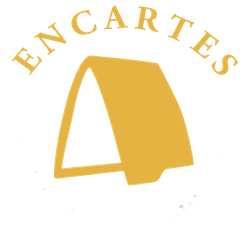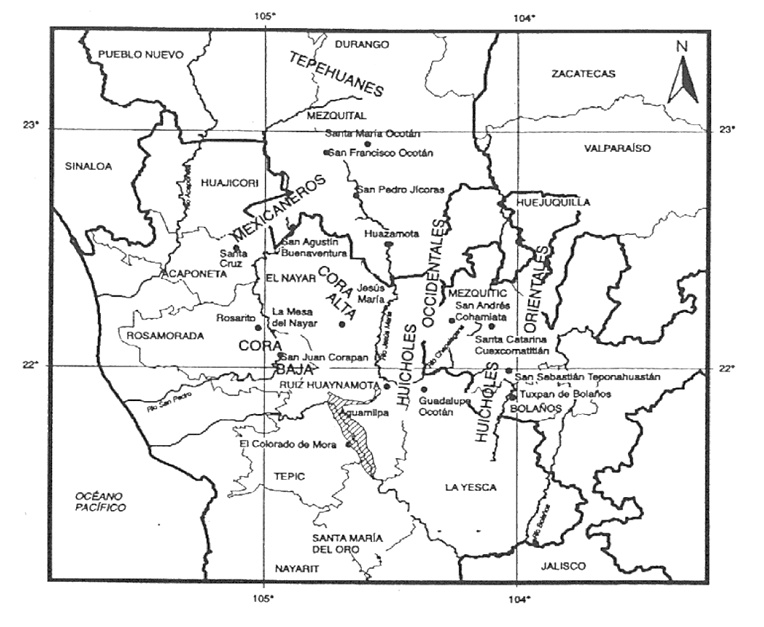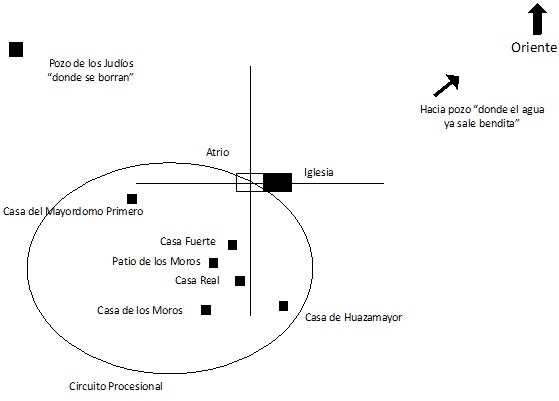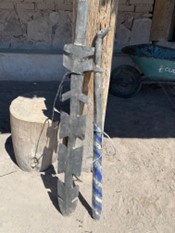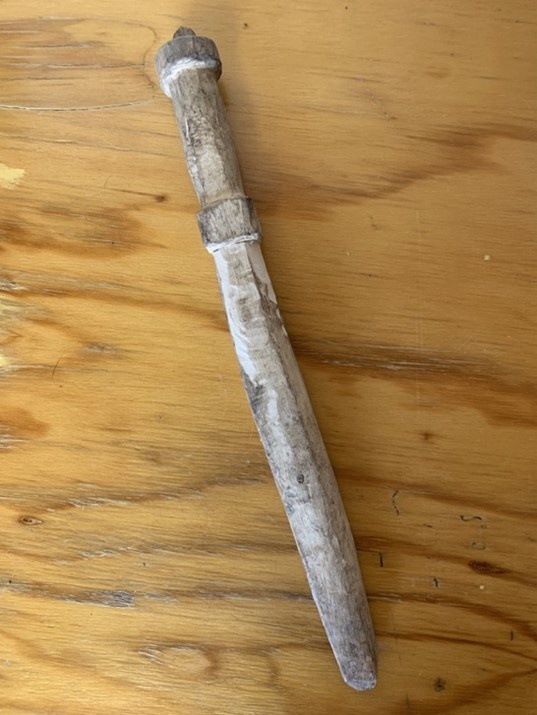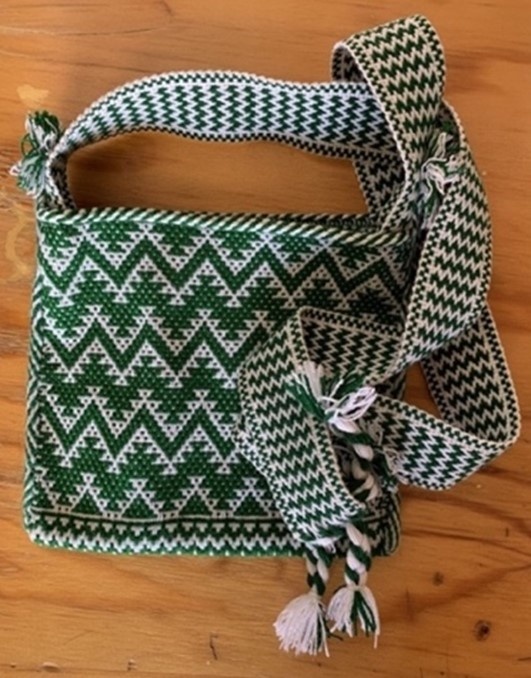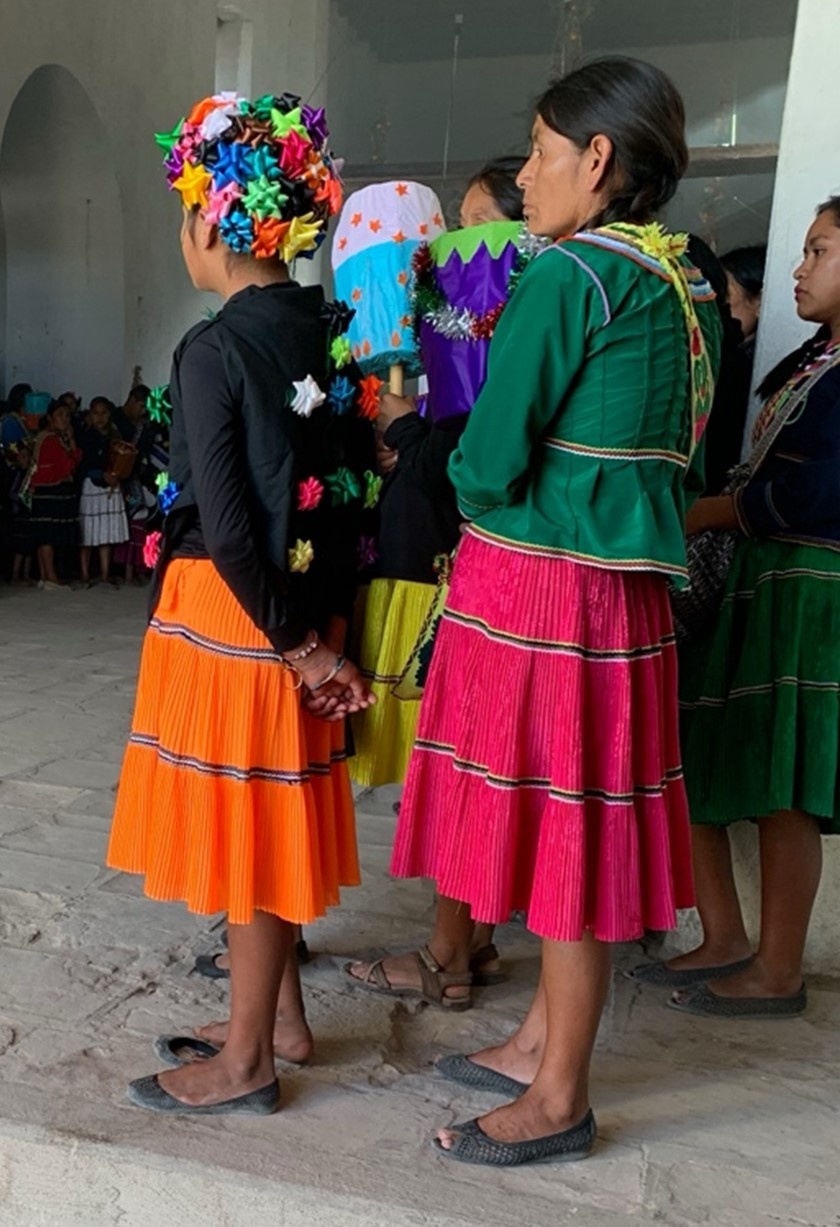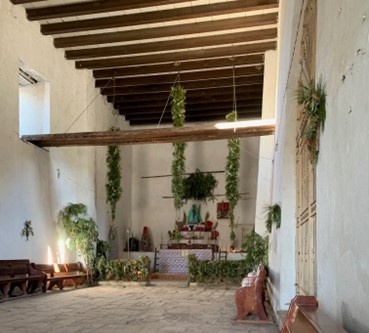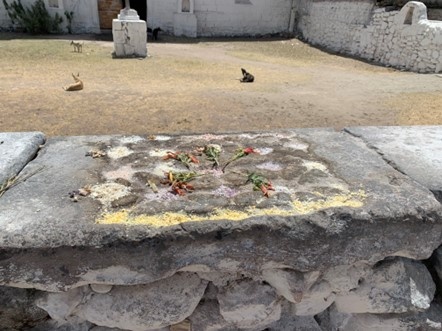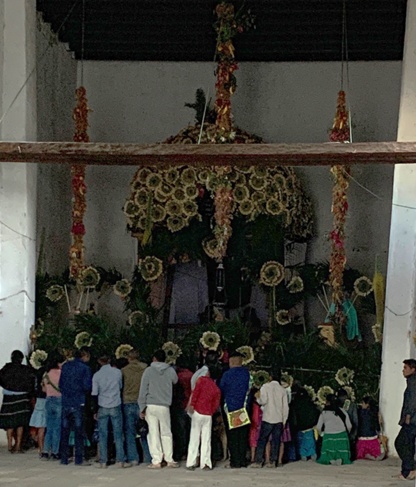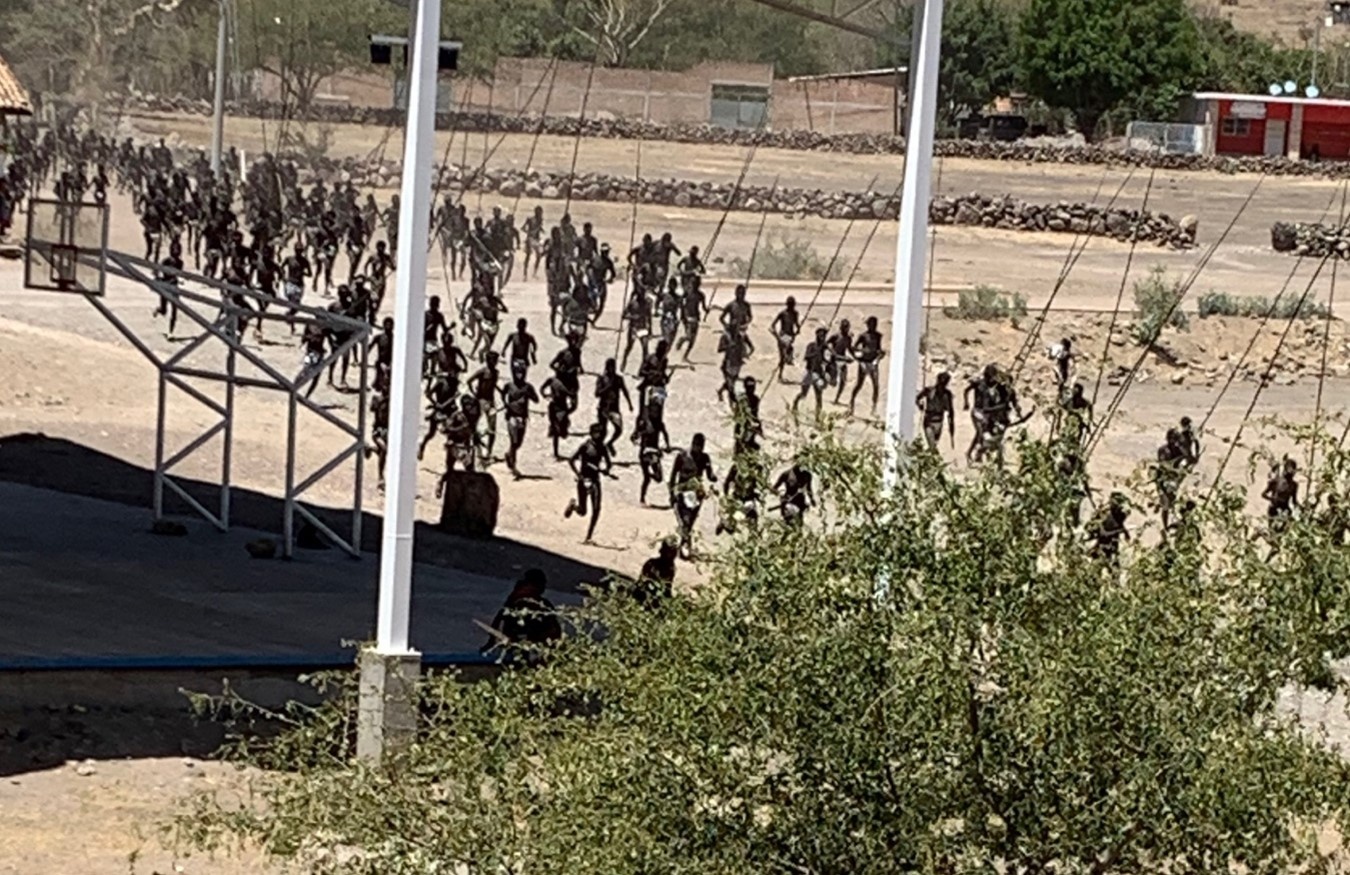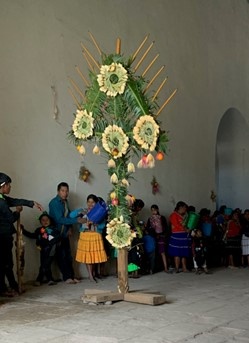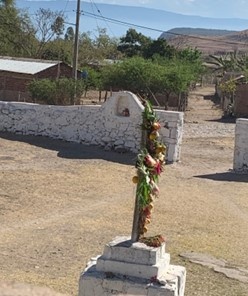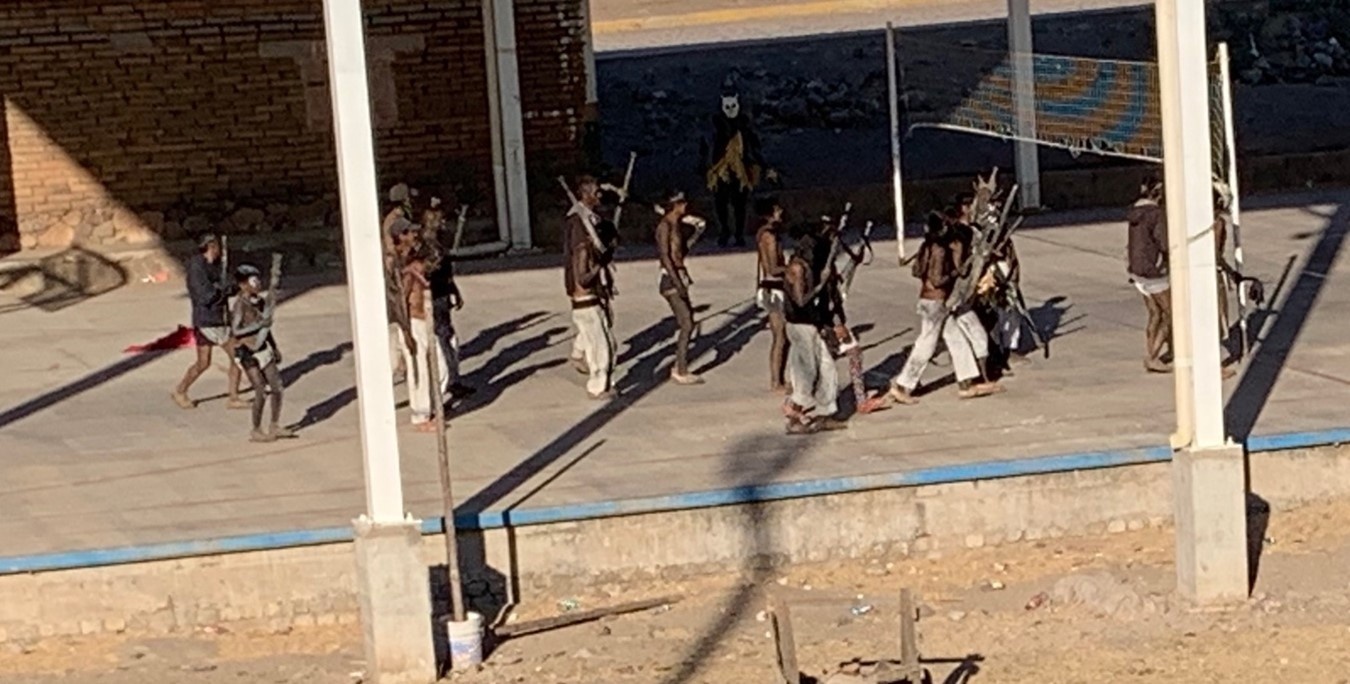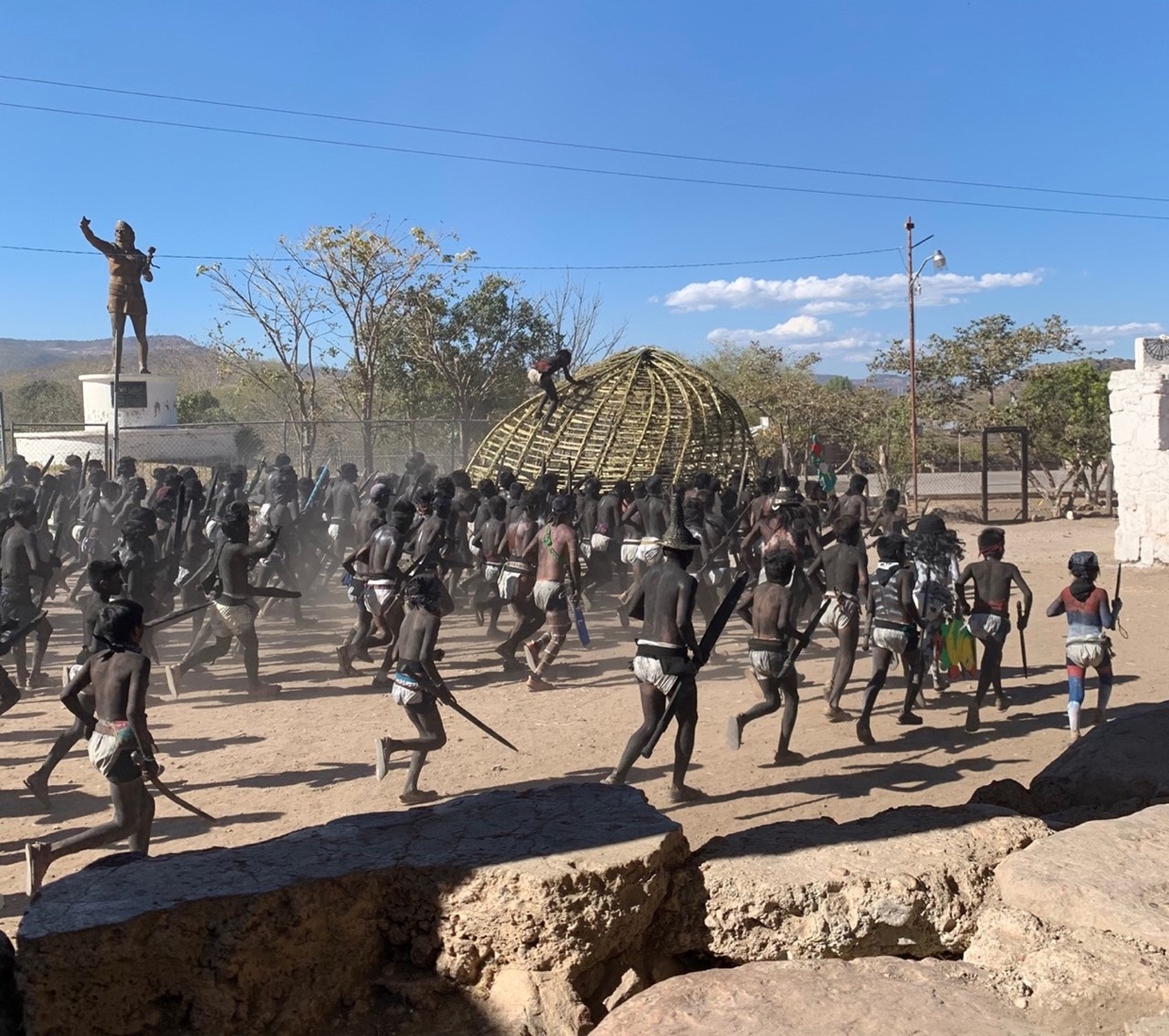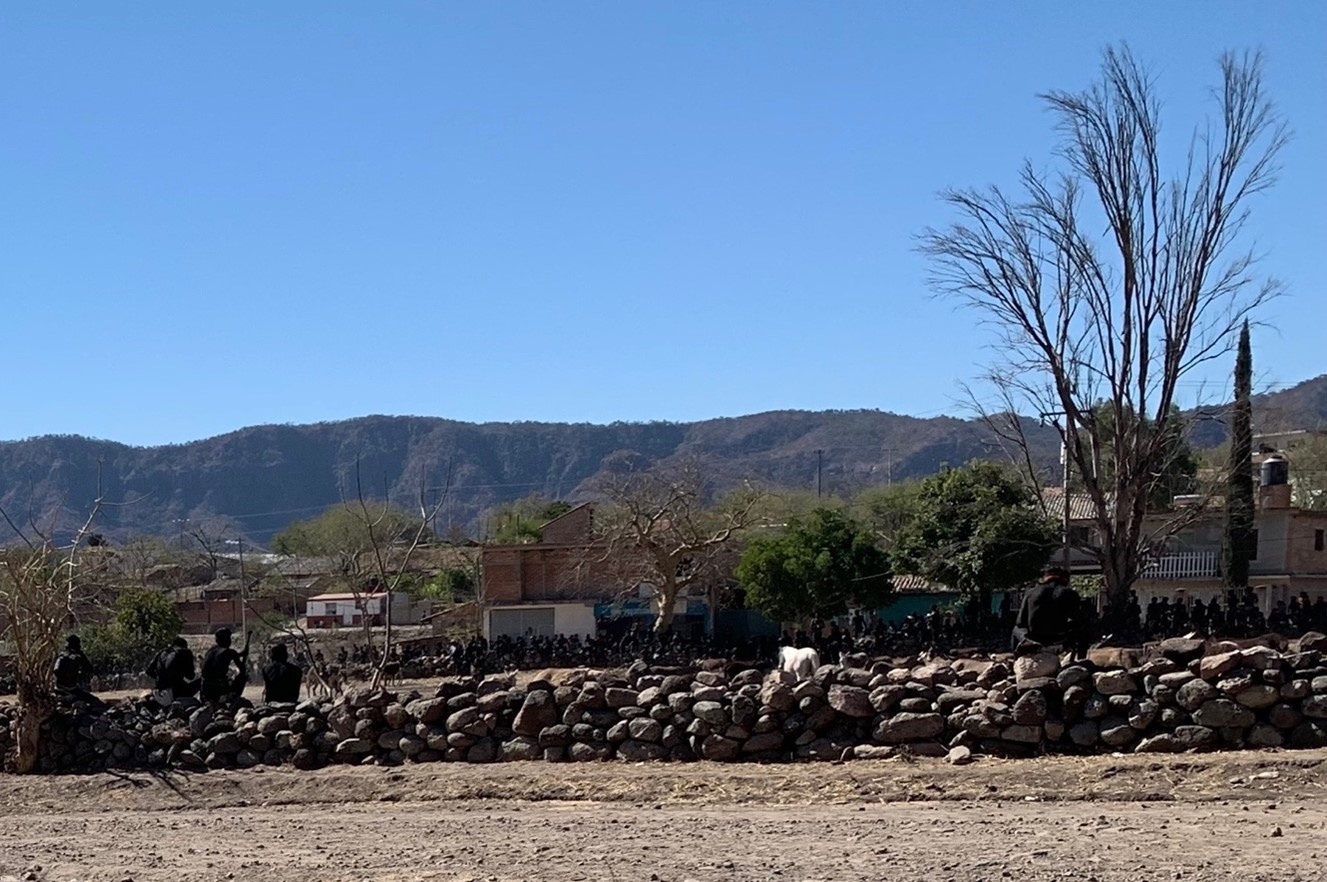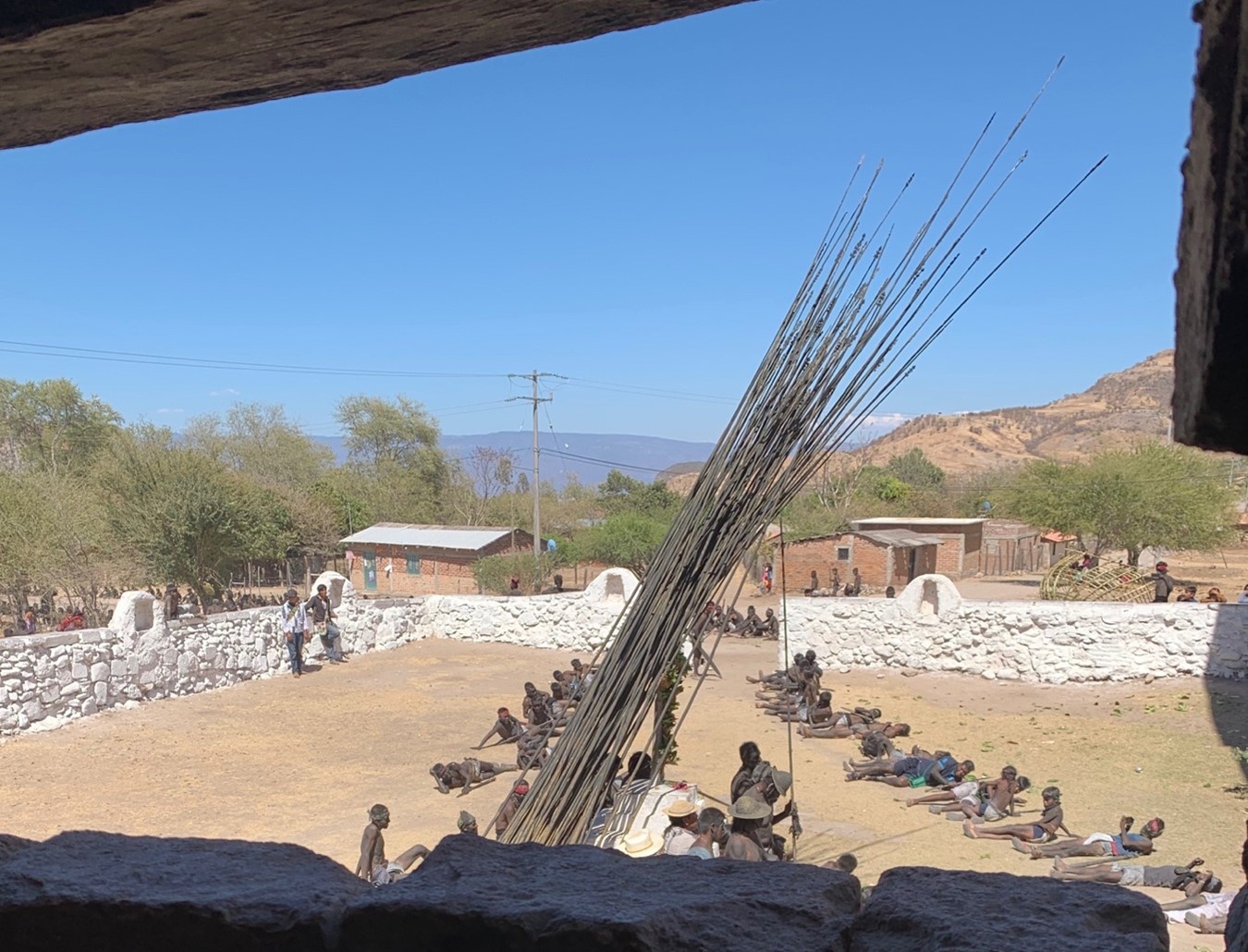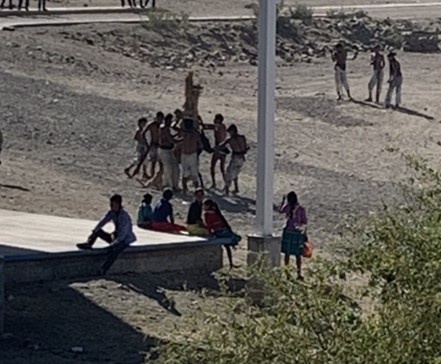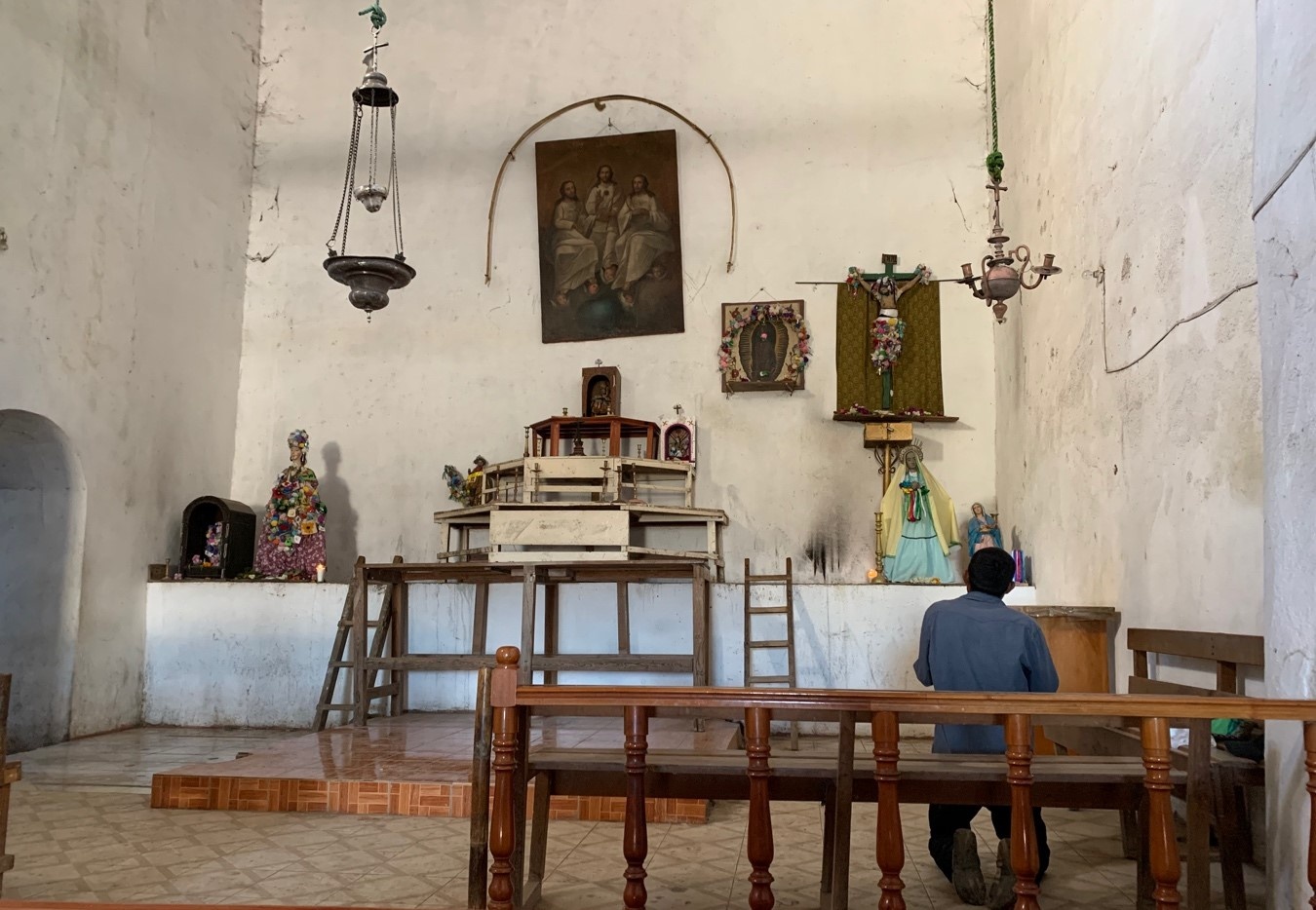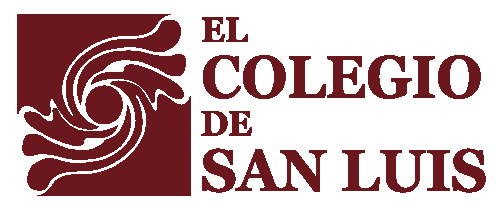Xumuavikari náayarite. Transformation and activities of the tiznados of the Cora Holy Week in Nayarit.
- Adriana Guzman
- ― see biodata
Xumuavikari náayarite. Transformation and activities of the tiznados of the Cora Holy Week in Nayarit.
Receipt: January 31, 2024
Acceptance: May 29, 2024
Abstract
Based on ethnography in Mesa del Nayar, Nayarit, the process of transformation throughout the year of the tiznados, the main creators of Holy Week or Judea, is presented. náayari (Cora) and their most important activities during the festival, as well as the condensation of different creations in the same ritual: the death and resurrection of Christ (Christ-Sun for the Cora), the beginning of Christianity; the Genesis, the origin of the universe for Catholicism and the creation of the world according to the Cora, the origin of the universe for Catholicism and the creation of the world according to the Cora. naiyarite.
Keywords: deleted, Génesis, naiyari world, transformation process
xumuavikari náayarite: the tiznados, cora holy week in nayarit
Drawing on an ethnographic study in Mesa del Nayar, Nayarit, this article explores the yearlong transformation of the stainedthe main organizers of Holy Week or the Náayari (Cora) Judea, and their role during the festivity. It analyzes how different creations mingle together in the same ritual, specifically, the death and resurrection of Christ (Christ-Sun for the Cora people), the birth of Christianity; and Genesis, which represents the origin of the universe in Catholicism and the creation of the world according to the Náayarite.
Keywords: Holy Week, the erased, transformation, Genesis, náayari world.
In the Sierra Madre Occidental, the following share territory náayari (coras),1 wixárica (Huicholes), o'dam (Tepehuanos), mexican (mexicaneros) and mestizos. Specifically the naiyarite inhabit the state of Nayarit, within the so-called Cora Alta (high parts of the sierra), in the municipality of Del Nayar, and those that form part of the Cora Baja (foothills of the sierra), in Acaponeta, Rosamorada and Ruiz:
The Judea or Holy Week is held in communal headwaters.2 in which the inhabitants of localities belonging to each one of them -who even come from abroad- gather together, in which the "tonada" varies.3 and highlight the different "styles":4 In the Cora Alta, it is carried out in Santa Teresa, Dolores, Mesa del Nayar, San Francisco and Jesús María; and in the Cora Baja, in San Juan Corapan, Presidio de los Reyes, Mojocuautla, Rosarito, San Juan Bautista, San Blasito and Huaynamota.
Introduction
Existing publications on Judea náayari within the Cora Alta come from Jesús María, the head of the municipality of Del Nayar (González Laporte, 1994; Imafuku, 1993 [1987]; Valdovinos, 2002) and from the communities of Santa Teresa (Coyle, 1997; Jiménez, 2006; Castillo Badillo and Coyle, 2021) and Dolores (Jáuregui, 2016). Within the Cora Baja, there are works on the villages San Juan Bautista (Muratalla, 2015) and Presidio de los Reyes (Jáuregui and Magriñá, 2015). There are also general analyses derived from or related to the Judea. náayari (Jáuregui, 2000 and 2008; Benciolini, 2012), in addition to monographic and documentary reports (Benítez, 2019 [1970]; González Ramos, 1972; Muñoz, 1973). To date, there is no publication5 about Holy Week in Mesa del Nayar, the place where this work is centered.6
Most of these works consist of descriptions and/or analyses that concentrate on the Easter Triduum and look at Holy Week as a seasonal rite of passage from the dry season to the rainy season, as well as for men, and follow the approach of Konrad Theodor Preuss (1998 [1906th, 1906b, 1908th, 1908b, 1908c, 1908d, 1908e, 1909th, 1909b, 1912, 1928]), centered on the astral struggle between the forces of the diurnal world and those of the underworld. In general terms, this proposal holds that the Jews are erased because they are beings of the underworld who come up to earth to capture Christ, related to the sun, who must "die" in order to make it possible for the rains to fertilize the earth. However, none of these works has pointed out the long process of individual and community transformation that takes place throughout the year to make this event possible.
The above is fundamental because for the naiyarite the world is not something given, but must be built constantly with ritual work and always in correspondence with the "path" of the sun that travels the luminous world during the day and the dry season and the world below, often called the underworld, during the night and the rainy season. Throughout the year, besides performing different rituals in correspondence with the above, there is a constant preparation of the Jews, whose activity in Holy Week will be vital because it is the moment in which the land that the rains will fertilize will be created.
This creation of the world is understood in different ways; on the one hand, it implies letting the world below, where all potential life is found, "rise" to the surface of the earth. naiyarite "It is only at night", because "when there is sun it is not possible". Once the earth is created, it will have to be fertilized with the vital force contained in the bones of the ancestors that, after being buried, "grow like flowers", which are then seeds, fruits that germinate the earth. On the other hand, the creation of the world takes place "in parts", in which it is revealing that they follow the moments of creation according to Genesis.7
Due to the above it has been possible to establish that in the Judea náayari is condensed8 the formation of three great creations: on the one hand, the death and resurrection of Christ, the well-known historical beginning of Christianity and its annual renewal; on the other hand, Genesis, the origin of the universe for Catholicism; and, finally, the creation of the world according to the naiyarite. In the works of specialists in the region, the first creation has been mentioned, but the last two have never been commented on.
In the present text, the presentation has been chosen in chronological order to show both the gradual transformation of the Jews throughout the year, as well as the activities of Holy Week related to the three creations mentioned. In order to give an account of the above, first a brief presentation of the makers of the Judea is made; then the outstanding ethnographic moments are shown, throughout the year, of the gradual community and individual transformation thanks to which the three great creations that take place during Holy Week are possible, which, in the following section, are observed from certain ritual actions, carried out in conjunction with the Genesis and songs. náayarite.
Home
XumuavikariThe names given by the locals are: tiznados, tiznados, borrados, negros, pintos, pintados, pintados or judíos. naiyarite the larger group of male participants, a veritable army, during the Xumuavika jetse The "Feast of the Blacks", the Holy Week or Judea (due to the participation of the Jews) between the naiyaritefrom Nayarit. The distinctive characteristic, which gives them their name, is that they are made with olote and dry grass burned and dissolved in water, becoming completely blackened, dark, which is the culminating point of a transformation that develops gradually throughout the year.
As established by the Council of Trent (1545-1563),9 The celebration begins on Friday of Sorrows and ends on Easter Sunday, ten days of intense ritual activity, especially during the Paschal Triduum. During this time, the Traditional Authorities give their place to the Principals of Judea, who become responsible for the community, as well as for the realization of the ritual and all the participants, who are the following:10
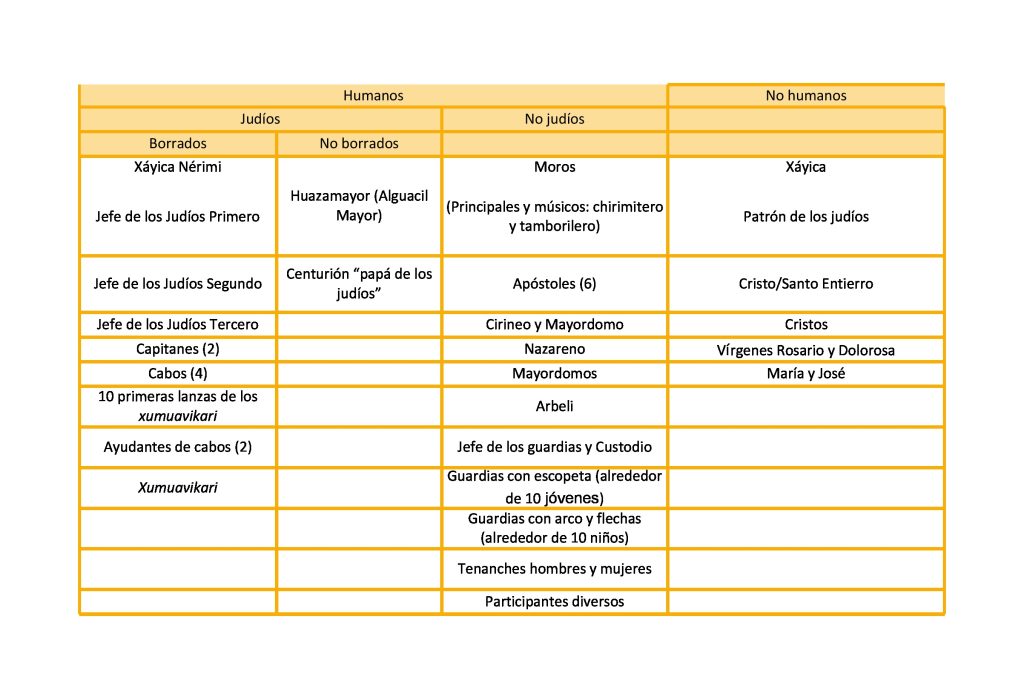
Paulatina transformation of the xumuavikari
The transformation of the space and the tiznados is not sudden, but it is a prolonged construction related to the "way of the sun" that begins after the celebration of the Holy Cross (May 3), day in which "the cross is already there, this way it stays", being Huazamayor, with the help of some Jews (without erasing himself), the one in charge of elaborating it and "raising it". It has an important moment during the Santísima Trinidad (June), the feast of Tayauthe sun in plenitude, moment in which Huazamayor "fixes".11 to the Holy Trinity12 which is located on the altar of the church. It continues in the heat of the summer, during the feast of Santiago/Santa Ana,13 July 25 and 26, when the santiagueros horsemen -among them Huazamayor, but without the attire that characterizes him during the Judea-, quarter roosters and hens, that is to say, in the sun,14 so that rains can finish falling during the "second round".15 of his season.
Then, the day after the Arrullo al Rey Nayar (Holy Kings, January 6), "when Christ is small",16 during the meal that Huazamayor17 is offered on January 7, in the "middle" of the festivities of the change of Traditional Authorities,18 the second and third Chiefs of the Jews appear with their masks looking for the Nazarene. Two days later, on January 9, "los limonazos" are performed, which are thrown at the horses of the Chiefs of the Moors -guardian horsemen of the Virgin of Guadalupe, the goddess of the world below- to call them, awaken them, resurrect them -just as the Jews are resurrected with lemons on Good Friday-.
Subsequently, in the Pachitas19 events are narrated, such as the search for the Nazarene by the Pachiteros for "having committed a sin with his mother".20 Following this celebration, on Shrove Tuesday, one of the Malinches21 of the Pachitas addresses Huazamayor telling him that he "tried" but "could not" and "failed", so now it is up to Huazamayor to continue with "the job" and capture Cristo-Sol.
The next day, Ash Wednesday, behind Huazamayor's house, the Governor hands over "the command" to the first one, who receives it with his back turned. Both actions -behind the house and with his back turned- indicate a distinctive characteristic of the group of the erased, which is their acting "backwards": words and actions that are the opposite of what they manifest or perform.
From this moment on and during the Fridays of Lent, Huazamayor and Centurion -who incarnate the ancestors who have held the same positions- will fast together with the other Principals of the Judea, and Huazamayor with the Principals of the Moors will travel the world on horseback, that is, the cardinal points in the vicinity of the community, in a circumference established in relation to the Well of the Jews, the place where they are erased, located to the east, in the lower parts of the stream that crosses the community.
During Lent, Huazamayor organizes the "messengers" who will get the supplies for the feast - bananas, oranges, honey, corn and other food for the Jews; flowers, various green branches, otate sticks to be used in the church arrangements; "special" water, and so on.22 with which everything will be blessed and distributed to the people; corn, grass and white earth to be erased and the long reeds that will be the spears-, which he keeps in his house,23 where they gather to make candles from native beeswax, or candle snuffers from mullein branches (Verbascum thapsus)The Elders are also responsible for arranging any object that will be used during Judea. One week before the beginning of the Holy Week, the Elders24 The community and Judea's Principals meet every day for the prayers and the making of the reed spears that the Jews will carry.
Also during Lent, those who have done "manda de borrarse" for five consecutive years present themselves before the Principales de la Judea -or send "recado"- to reiterate their commitment and inform how many years they have left to complete. Likewise, those who wish to "initiate manda" for themselves or for a family member, sometimes children in arms and all those who have some Easter Week position, also appear.
Also during this time, especially the closer it comes to its end, the future erased go in search of the wood of huásima, orange tree -or some other soft but resistant wood- to make their sword.25This is usually done alone or in the company of two, or at most three men. According to the design of the saber they want to make, the wood will be selected, after which the carving of the saber with machete and knife begins, an activity that takes several days (see photos 1 and 2).
While the men make their saber, the women make the blanket breeches and girdle, which are mandatory for all erasures, and, when requested by the men, they make small backpacks.26 with the colors and designs of their choice (see photos 3 and 4), which some use tied around their waists, where they recharge their long lances. They also make the candle holders (colored Chinese paper cylinders) that will be used in the women's processions. In the past, it was the time to make the flower bouquets -which have been replaced by colored bows- that are tied to the clothes and hair of the "little angels", girls,27 and to sew a skirt and blouse that will be worn for the first time after Easter Sunday (see photo 5).28
This time is not only a time of preparation for the celebration, but a fundamental part of the process of social transformation, of the territory and of each of the participants. Gradually, the community modifies its rhythms, stops its daily chores to dedicate itself to those necessary for the celebration: obtaining products, fasting -individually or collectively-, meetings with the principals or the manufacture of objects -candles, candle snuffers, spears-. The activities that are carried out individually - carving the sabers, elaborating textiles - are laborious, demand time, concentration, patience, skill, creativity, which propitiates introspection, changes of attitude, of corporal rhythms, of self-reflection.
The territory has also been transforming in many ways: the horse races from Santiago/Santa Ana, along with those of Huazamayor and the Moors held during Lent and those of the erased and Centurion during Judea, raise dust that is like tobacco smoke, that is, clouds that are ancestors that bring and are the rain. The circular dances of the Pachitas have stirred the vital force that is found in the world below, attracting it to emerge to the surface of the earth, of the world, which has been prepared with the journeys of Huazamayor and the Moors.
La Judea
Holy Week is the culmination of the long annual process, individual and communal, briefly mentioned, which makes possible the creation of the world in several senses: in it are condensed the death and resurrection of Christ (Christ-Sun for the Korans), beginning of Christianity; Genesis, origin of the world for Catholicism and the creation of the world according to the naiyarite.
For the Coras, the church29 is the same as the world, "but smaller", just like the community's processional circuit.30 Before the Easter Triduum, on Friday of Dolores, the deities are covered or removed from the altar. With green branches of pine, mango and laurel31 cover the handrail placed in front of the main altar, as well as the three long ropes that hold a censer in the center and on each side a candelabra, each of which has three candles that must be of local manufacture with native beeswax. They also place green branches on the cross of the choir, on those on the side walls and on the cross of the baptismal font, next to which they place more green branches. In the atrium, they tie them to the cross and at the stations of the processional circuit they place palm crosses.
From this day until Good Friday, when the sun goes down, the Jews "who are rain" go through the processional circuit, the same that Huazamayor has ridden during Lent, that is, the world they are creating with their steps.
On Easter Monday, all the "clothes" (blankets, tablecloths, napkins) of the church are taken to be washed. On Holy Tuesday, absolutely everything inside the church is removed, so that there is nothing, as before the Creation according to Genesis:33
In the beginning God created the heavens and the earth. And the earth was without form and void, and darkness was upon the face of the deep, and the Spirit of God moved upon the face of the waters.
At noon, on a petroglyph on the north wall of the atrium, facing the atrial cross and the entrance to the church, an Elder (widow with life tenure) places lines of crushed corn of the five colors:34 In the line and the holes to the north he distributes yellow corn; in the next, purple; the next, red; the next, white; and the last, pinto. In each of the four corners of the inner square she places small tamales of pinole from the five corns, along with five small peyotes. Around the center hole he places five flowers whose stems converge in the center and the buds face the cardinal points. It is the world náayari that is being created these days.
Meanwhile, the interior of the temple remains in darkness until dawn on Holy Wednesday, when there is a total transformation of the church. Since the morning, a large structure called "house of God" or "crown" adorned with "flowers" of green branches of sotol (Dasyrilion), at the top of which is placed a cross of Christ-Sun. The "crown" is suspended from the ceiling, below it they place a table that serves as an altar where the crucified Christ will be placed: the Sun, whose path "creates" the rainy and dry seasons. The "crown" is the sky with the Sun and the stars (flowers), the altar is the Earth, below which is "the water that surrounds the world". As Genesis says:
And God said, Let there be light; and there was light. And God saw that the light was good; and God separated the light from the darkness. And God called the light Day, and the darkness he called Night.
And God said, Let there be a firmament in the midst of the waters, and let it divide the waters from the waters. And God made the expanse, and separated the waters which were under the expanse from the waters which were above the expanse. And it was so. And God called the expanse Heaven.
And God said, Let there be lights in the expanse of the heavens to divide the day from the night; and let them be for signs to the seasons, for days and years, and let them be for lights in the expanse of the heavens to give light upon the earth. And it was so. And God made the two great lights, the greater light to rule by day, and the lesser light to rule by night; and he made the stars. And God placed them in the expanse of the heavens to give light upon the earth, and to rule in the day and in the night, and to divide the light from the darkness. And God saw that it was good.
And God said, Let the waters under the heavens be gathered together into one place, and let the dry land be described. And it was so. And God called the dry land Earth, and the gathering of the waters he called Seas. And God saw that it was good.
At dawn on Holy Thursday, the Jews are erased in the Well of the Jews, to the east of the community, and enter the village making an enveloping movement: one column from the north, another from the south and they meet to the west from where they run towards the atrium to "take" the church (see photo 9); this is the moment when the watery world below meets the water above (the rain, the Jews) to create the earth with the running of the Jews; from this moment until the opening of the Glory on Holy Saturday, the world is kept in darkness, because it is invaded by the darkness of the world below, the place where the fertility that will sprout on earth is always latent.
From the moment they are erased, they cannot be called by their name, they have no home and "lose" their family relationships, since they are all children of Huazamayor. The tiznados are beings of the world below, responsible for the creation of the world; that is why such a long transformation, that is why their military training, because they must fight against the power of the sun. Since in those times the world is inverted - that which is below has covered that which is above - they must be erased, as well as speak and act "backwards".
Shortly after two o'clock in the afternoon the persecution of the Nazarene begins, who first is with the Jews, suddenly goes to the house of Huazamayor from where he leaves running and pretends to be asleep under a tree; he is discovered by the erased, who in columns, one on one side and in one direction and the other on the other in the opposite direction, surround him and corner him, but he escapes. In a second attempt they do the same near the Patio de los Moros, but again he escapes, until the third occasion, around three o'clock in the afternoon, in which they capture him near the church. He is arrested by a Captain and then other Jews tie him up and throw him on the ground, face up, with his head to the west, and he is tried and sentenced. They present him in front of the church, they take him to make the Way of the Cross inside the atrium and, while the Captains climb on the atrial cross, they crucify the Nazarene on a large wooden cross on which they take him to make the processional circuit through the community, which ends at the Strong House. Afterwards, the Jews go to Huazamayor's house where they dance and sing,35 creating the world understood in the way náayeri as mentioned:
Where are we really?
We are in Téijmata' [east].
Where are we really?
We are in Huáahuta [west].
Where are we really?
We are in Tzéréeme'en [north].
Where are we really?
We are in Cuamereché [south].
Where are we really?
We are in Tajapuá (up)
Where are we really?
We are in Tajeté (below)
Where are we really?
We are in Nainjapua (everywhere)
(Casad, 1989: 114).
While this is happening on the outside, inside the church from dawn there is a new transformation; the "crown" and the green branches are thrown outside the atrium, on the eastern side, and everything is filled with carnation flowers (carnation).Preudobombax ellipticum) red and white fruits, especially oranges.
In the afternoon/evening, the "women's procession" takes place with the "little angels", led by Centurion on his harnessed mount, followed by the crucified Nazarene and the Holy Burial on a platform and surrounded by the "erased", which resembles a "snake".36 with the "body" full of flowers or "flowery serpent": the vital force of the world below that has given death to Christ-Sun, which is necessary for the rains to be able to do their task. The colorful "little angels" spread the vital force in the form of flowers (bows) all over the earth that has been created by the Jews during their processional circuit: the earth blooms, as it says in Genesis:
Then God said, "Let the earth bring forth green grass, grass yielding seed, a fruit tree yielding fruit after its kind, its seed in it, upon the earth. And it was so. So the earth brought forth green herb, herb yielding seed after its kind, and a tree yielding fruit, whose seed was in it, after its kind. And God saw that it was good.
Both are full of flowers, in the same way as the whole church.
On Good Friday the church is again completely stripped. While this happens, the "instruction" of the erased takes place: led by an adult Jew, the blackened children must follow him "without losing step"; the older one leads them uphill through different parts of the community, while the children are left on the road completely suffocated. The young Jews make formations "in square" (see photo 12): at the head about five erased behind which integrate as many as they want, respecting the places, they advance in line with "the step of the toad",37 they move, emitting their characteristic cry, unhurriedly, from their "barracks".38 to other nearby spaces and returning to its place. All this is repeated several times until sunset.
Around three o'clock in the afternoon, Jews paint white or colored motifs on the black smut and appear with stuffed animals, similar to the following Genesis moment:
And God said, Let the waters bring forth living creatures, and birds that fly over the earth, in the open expanse of the heavens. And God created the great sea monsters, and every living thing that moveth, which the waters brought forth after their kind, and every winged fowl after his kind. And God saw that it was good. And God blessed them, saying, Be fruitful and multiply, and replenish the waters in the seas, and let the birds multiply on the earth.
Then God said, "Let the earth bring forth living creatures after their kind, beasts and serpents and animals of the earth after their kind. And it was so. And God made beasts of the earth after their kind, and cattle after their kind, and every creeping thing that creepeth upon the earth after his kind. And God saw that it was good.
After being painted, they make a procession with the "crown" on a platform, on top of which is placed an erased child (see photo 13). Then the painted ones are divided into two groups. One goes around the town going up on the south side, and the other does the same on the north. The two groups meet to the west of the town, but this time as enemies. They pass by each other and shout three times at each other, as a challenge, and then engage in a fierce fight in which they throw dung at each other and then fight hand to hand using sabers and spears. One group wins and the one that was "killed" is revived with lemon juice. After being revived, the groups engage in battle again and ambush each other. The group that was defeated wins this time and again the "dead" are brought back to life with lemon juice.
At the conclusion of the procession, a painted man dressed as a woman appears, shouting "sins".39 of the people from outside the court, related to the "creation of man" according to Genesis:
And God said, Let us make man in our image, after our likeness: and let them have dominion over the fish of the sea, and over the fowl of the air, and over the cattle, and over all the earth, and over every creeping thing that creepeth upon the earth. And God created man in his own image, in the image of God created he him; male and female created he them. And God blessed them, and God said unto them, Be fruitful, and multiply, and replenish the earth, and subdue it: and have dominion over the fish of the sea, and over the fowl of the air, and over every creeping thing that moveth upon the earth.
In the evening, the great meal of the Jews consists obligatorily of vegetable products - fruits: oranges, bananas; corn tortillas, rice - and animal products - honey, fish, eggs - as indicated in Genesis:
And God said, Behold, I have given you every plant yielding seed which is upon the earth, and every tree, in the which is fruitful and yields seed; to you it shall be for meat. And to every beast of the earth, and to every fowl of the air, and to every creeping thing that creepeth upon the earth, wherein is life, every green plant shall be meat for you. And it was so. And God saw all that he had made, and, behold, it was very good.
On the morning of Saturday of Glory, the Jews gather all the donkeys of the community and lock them in the Patio de los Moros where they incite them to mate (see photo 14); it is the culmination of the process of fertilization of all that is alive: it has started with green branches - on Friday of Sorrows -, then with flowers and fruits - on Holy Thursday - that "the little angels" have been in charge of disseminating through the earth created by the passing of the Jews and concludes with the animals - the mating of the donkeys -, which is possible because the flowers (seeds) have germinated and filled the whole earth with colors and food.
In the afternoon, in the middle of great agitation, the Glory is Opened with music, bells, rockets and great movement to the interior and outside of the church (see photo 15); when Nazareno leaves running of the same one, the Jews that roll on the floor die and their sabers and lances are destroyed by Centurión, after which they run to the river to bathe. At that moment a long mass begins, accompanied by minuet music, during which the participants of the Judea leave the temple and the Traditional Authorities and the women enter. Before the end of the mass, some Jews already bathed go to the church "to tell God that they have fulfilled".
At the end of the mass, the Traditional Authorities leave the church and go to the porch of the Casa Fuerte, where they occupy their usual places and hang up their command staffs: they have recovered the government of the community. Shortly after, several Jews, already bathed but still wearing the obligatory blanket underwear, ride a Judas made of grass mounted on a donkey (see photo 16), then throw him to the ground, surround him and set him on fire, shout at him and throw things at him.
On Easter Sunday, all the gods finally take their place.
The altar and clean the entire church (see photo 17).
Judea has ended, but not so the activities of the Jews who have done manda, because on May 3, when "the cross remains", at the opening of the rainy season, they have to carry ritual deposits to various places of particular importance for the Jews. naiyarite. Then, the newly risen Christ-Sun will have its culminating moment in the Holy Trinity (June), the feast of Tayau, the sun in fullness, who will be again quartered in Santiago/Santa Ana... and the cycle continues.
Between Saturday and Sunday, Huazamayor and Centurion distribute among the people the food that their families and helpers have prepared; some of this food is then eaten at each of the different rituals during the year, including the mitotes, one of the ways in which they link with the rituals that are performed in relation to the growth of corn, linking the death and resurrection of Christ-Sun... and the cycle goes on and on and on.
Final comments
Among specialists, the importance of Holy Week has been constantly pointed out as an important event for the náayarite, as a rite of seasonal passage and of men, but until now the condensation of the three great creations that take place in the same ritual had not been commented on: the death and resurrection of Christ-Sun, the beginning of Christianity; Genesis, the origin of the world for Catholicism; and the creation of the world according to the naiyarite. To account for them not only makes it possible to understand even more the scope of the ritual, it is also an approach to the knowledge of the world below or underworld. náayari as the place of all creation and one of the ways in which creation is possible, that is, when it merges with the luminous world and "reaches" the earth; it is the conjunction of light, the sun, the sky, darkness, water, the world below, always in the place where the earth is, from where humans work to make it possible. There are, then, three bundles of elements required: on the one hand, the work of the sun, of the luminous, of what is above; on the other hand, the work of the waters, of the dark, of what is below and, finally, the work of the humans who throughout the year prepare the encounter between everything so that it results in the creation and fertility of the earth; that is why it is important to mention the long process of community and individual preparation that make the Judea possible; it is the vitality of dances, music, seeds, flowers and plants: creation generated from the walk of the Jews, where the flowers of the little angels germinate.
The analysis of the three great creations carried out in Judea also allows us to know some of the historical processes that are not so easy to find in documents, because although they say what they were intended to teach - in this case evangelization - not everything is written as to how it was carried out. naiyarite shows that the two great creations for Catholicism - Genesis and the rise of Christianity with the death and resurrection of Christ - have been brought together on the one hand, and on the other hand, both with the creation of the world according to the naiyaritethree beams of elements in relation to each other.
Bibliography
Benítez, Fernando (2019 [1989]). “Nostalgia del paraíso”, Los indios de México iii, pp. 171-226.
Benciolini, María (2012). “Entre el orden y la transgresión: el consumo ritual del peyote entre los coras”, Cuicuilco, 19 (53), pp. 175-193.
— (2014). “Iridiscencias de un mundo florido: estudio sobre relacionalidad y ritualidad cora”. Tesis de Doctorado en Antropología. México: Universidad Nacional Autónoma de México.
Castillo Badillo, Frine y Philip E. Coyle (2021). “The Holy Week of Puáaxku jitsé in Santa Teresa, Nayarit, México, en W. Frej (Coord.), Seasons of Ceremonies: Rites and Rituals in Guatemala and México. Santa Fe: Museum of New Mexico Press, pp. 162-195.
Coyle, Theodore (1997). “Hapwán Chánaka (‘On Top of the Earth’): The Politics and History of Public Ceremonial Tradition in Santa Teresa, Nayarit, México”. Tesis de Doctorado en Antropología. Tucsón: University of Arizona.
Casad, Eugene (1989). “Topónimos coras”, Tlalocan. Revista de Fuentes para el Conocimiento de las Culturas Indígenas de México, núm. 11. México: Instituto de Investigaciones Históricas/Instituto de Investigaciones Filológicas, Universidad Nacional Autónoma de México, pp. 101-128.
Dutcher Mann, Kristin (2010). The Power of Song. Music and Dance in the Mission Communities of Northern New Spain, 1590-1810. Stanford: Stanford University Press/The Academy of American Franciscan History.
Génesis: https://www.bible.com/es/bible/149/GEN.1.RVR1960.
González Laporte, Verónica (1994). “La ‘Judea’: Rituel de la Semaine Sainte Cora (Nayarit, Mexique)”. Tesis de grado de Antropología. Sorbone Nouvelle-Paris iii: Institut des Hautes Etudes de L’Amerique Latine.
González Ramos, Gildardo (1972). Los coras. México: Consejo Nacional para la Cultura y las Artes/Instituto Nacional Indigenista.
Guzmán, Adriana (2002). Mitote y universo cora. México: Instituto Nacional de Antropología e Historia.
— (2024). Nayar: el sol de la oscuridad. Tiempo, cuerpo, espacio y persona. México: Instituto Nacional de Antropología e Historia.
Guzmán, Arturo (1997). “Los coras. Semana Santa en la Mesa del Nayar”, Revista de Geografía Universal, 2, 3, 4, pp. 468-487.
Houseman, Michel (2022) [2006]. “Relacionalidad”. Trad. de Adriana Guzmán. Antropología. Revista Interdisciplinaria del inah, 6 (13), pp. 107-117.
— y Carlo Severi (1994). Naven ou Le donner á voir. Essai d’interprétation de l’action rituelle. París: cnrs/Éd. De la Maison des Sciences del’Homme.
Jáuregui, Jesús (2000). “La Judea de los coras: un drama astral en primavera. México en movimiento, La religión popular”. Actas del Sexto Encuentro de Mexicanistas en Holanda, organizado en Groningen el 11 de noviembre 1999. Hub Hermans/Dick Papasek y Catherine Raffi-Béroud (comps.). Centro de Estudios Mexicanos, Groninen, pp. 28-53.
— (2008). “Una contribución a la teoría de los ritos de paso a partir de la Judea (Semana Santa) de los coras”, Antropología en Boletín Oficial del Instituto Nacional de Antropología e Historia, Nueva Época 83-84, pp. 53-70.
— (2016). “El sol nocturno asciende al altar del templo: La Judea en Guajchájapua (Dolores) 2000”, en Andrés Oseguera Montiel y Antonio Reyes Valdez (coords.). Develando la tradición. Procesos rituales en las comunidades indígenas de México: volumen iv. México: Secretaría de Cultura/inah, pp. 95-135.
— y Laura Magriñá (2015). “Las grandes serpientes oscuras invaden el lugar del algodón (Muúxate’e). La función de los cantos en la Judea Cora”, en Catherine Good Eshelman y María Alonso Bolaños (comps.). Creando mundos, entrelazando realidades: cosmovisiones y mitologías en el México indígena: vol. ii. México: inah-México, pp. 177-258.
— et al. (2003). “La autoridad de los antepasados: ¿un sistema de organización social de tradición aborigen entre los coras y huicholes?”, en S. Millán y J. Valle (coords.). La comunidad sin límites: la estructura social y comunitaria de los pueblos indígenas de México. México: inah, vol. iii, pp. 113-219.
Jiménez, Ángel (2006). “Simbolismo, ritualidad y forma procesual: el ciclo ceremonial y ritual de los nayeris de Santa Teresa”. Tesis de licenciatura en Etnología. México: Escuela Nacional de Antropología e Historia.
Magriñá, Laura (2022). El Gran Nayar jesuítico (1722-1767). La conformación de la matriz cultural indígena de raigambre aborigen de los coras contemporáneos. México: Instituto Nacional de Antropología e Historia/Universidad Nacional Autónoma de México.
Muñoz, Alfonso (dir.) (1973). Zaya’hu. La pasión de Cristo según los coras de la Mesa del Nayar (película de acetato). Patrimonio fílmico del Instituto Nacional de Antropología e Historia (inah) preservado y digitalizado por la Cineteca Nacional de México. México: Instituto Nacional de Antropología e Historia (inah)/Secretaría de Educación Pública (sep). https://www.youtube.com/watch?v=ED-14724PjE [6/V/20]
Muratalla, Benjamín (2015). “La representación del universo en los cantos ceremoniales del pueblo cora”. Tesis de Doctorado en Antropología. México: Universidad Nacional Autónoma de México.
Neurath, Johannes (2001). “La Semana Santa cora de la Mesa del Nayar, Arqueología Mexicana, 9 (52), pp. 72-77.
Preuss, Konrad Theodor (1998 [1906a]). “Observaciones sobre la religión de los coras”, en Jesús Jáuregui y Johannes Neurath (comps.). Fiesta, literatura y magia en el Nayarit. Ensayos sobre coras, huicholes y mexicaneros de Konrad Theodor Preuss. México: Instituto Nacional Indigenista (ini)/Centro de Estudios Mexicanos y Centroamericanos (cemca), pp. 105-118.
— (1998 [1906b]). “Más información acerca de las costumbres religiosas de los coras, especialmente sobre los portadores de falos en Semana Santa”, en Jesús Jáuregui y Johannes Neurath (comps.). Fiesta, literatura y magia en el Nayarit. Ensayos sobre coras, huicholes y mexicaneros de Konrad Theodor Preuss. México: Instituto Nacional Indigenista (ini)/Centro de Estudios Mexicanos y Centroamericanos (cemca), pp. 127-137.
— (1998 [1908a]). “Un viaje a la Sierra Madre Occidental de México”, en Jesús Jáuregui y Johannes Neurath (comps.). Fiesta, literatura y magia en el Nayarit. Ensayos sobre coras, huicholes y mexicaneros de Konrad Theodor Preuss. México: Instituto Nacional Indigenista (ini)/Centro de Estudios Mexicanos y Centroamericanos (cemca), pp. 213-233.
— (1998 [1908b]). “Resultados etnográficos de un viaje a la Sierra Madre Occidental”, en Jesús Jáuregui y Johannes Neurath (comps.). Fiesta, literatura y magia en el Nayarit. Ensayos sobre coras, huicholes y mexicaneros de Konrad Theodor Preuss. México: Instituto Nacional Indigenista (ini)/Centro de Estudios Mexicanos y Centroamericanos (cemca), pp. 235-260.
— (1998 [1908c]). “Entre los indígenas de la Sierra Madre Occidental”, en Jesús Jáuregui, y Johannes Neurath (comps.). Fiesta, literatura y magia en el Nayarit. Ensayos sobre coras, huicholes y mexicaneros de Konrad Theodor Preuss. México: Instituto Nacional Indigenista (ini)/Centro de Estudios Mexicanos y Centroamericanos (cemca), pp. 261-264.
— (1998 [1908d]). “Los cantos religiosos y los mitos de algunas tribus de la Sierra Madre Occidental”, en Jesús Jáuregui y Johannes Neurath (comps.). Fiesta, literatura y magia en el Nayarit. Ensayos sobre coras, huicholes y mexicaneros de Konrad Theodor Preuss. México: Instituto Nacional Indigenista (ini)/Centro de Estudios Mexicanos y Centroamericanos (cemca), pp. 265-287.
— (1998 [1908e]). “La religión astral mexicana en tiempos prehispánicos y en la actualidad”, en Jesús Jáuregui. y Johannes Neurath (comps.). Fiesta, literatura y magia en el Nayarit. Ensayos sobre coras, huicholes y mexicaneros de Konrad Theodor Preuss, Instituto Nacional Indigenista (ini)/Centro de Estudios Mexicanos y Centroamericanos (cemca), México, pp. 317-325.
— (1998 [1909a]). “Colección etnográfica de México”, en Jesús Jáuregui y Johannes Neurath (comps.), Fiesta, literatura y magia en el Nayarit. Ensayos sobre coras, huicholes y mexicaneros de Konrad Theodor Preuss. México: Instituto Nacional Indigenista (ini)/Centro de Estudios Mexicanos y Centroamericanos (cemca), pp. 291-293.
— (1998 [1909b]). “Los cantos dialogales del Rig Veda a la luz de los cantos religiosos de los indios mexicanos”, en Jesús Jáuregui y Johannes Neurath (comps.). Fiesta, literatura y magia en el Nayarit. Ensayos sobre coras, huicholes y mexicaneros de Konrad Theodor Preuss. México: Instituto Nacional Indigenista (ini)/Centro de Estudios Mexicanos y Centroamericanos (cemca), pp. 387-401.
— (1998 [1912]). “El pensamiento mágico de los coras”, en Jesús Jáuregui y Johannes Neurath (comps.). Fiesta, literatura y magia en el Nayarit. Ensayos sobre coras, huicholes y mexicaneros de Konrad Theodor Preuss. México: Instituto Nacional Indigenista (ini)/Centro de Estudios Mexicanos y Centroamericanos (cemca), pp. 327-332.
— (1998 [1928]). “El mito de Cristo y otros mitos solares de los mexicaneros (texto, traducción y comentarios)”, en Jesús Jáuregui y Johannes Neurath (comps.). Fiesta, literatura y magia en el Nayarit. Ensayos sobre coras, huicholes y mexicaneros de Konrad Theodor Preuss. México: Instituto Nacional Indigenista (ini)/Centro de Estudios Mexicanos y Centroamericanos (cemca), pp. 355-367.
Severi, Carlo (2008). “El Yo-memoria. Una nueva aproximación a los cantos chamánicos amerindios”. Trad. de Saúl Millán. Cuicuilco, 15 (42), pp: 11-28.
Adriana Guzman. Dancer. Doctor, professor-researcher of the enah. Member of the National System of Researchers. Specialist in anthropology of the body and art, particularly in ritual and artistic processes of the Gran Nayar and contemporary life. Member of several research seminars. She has coordinated and participated in numerous congresses, seminars and publications, among which the following individual books are worth mentioning Mitote y universo cora (2002), Revelation of the body. The eloquence of the gesture (2016) y Nayar, the sun of the darkness: time, body, space and person (2024); as well as the collective books Choreographic Mexico. Dancers of letters and feet, Aesthetic paths (both 2017), Bibliographic catalog of research on dance in Mexico. (2018); Dilemmas of representation: presences, performance, power (2017), Concerns about Das Unheimliche in society and art (2019), the latter two co-coordinated with Anne Johnson and Rodrigo Díaz Cruz; Presence. Aesthetic and political actions (2023) in co-coordination with Nelson Artega and Jesús Jáuregui The tricksteran anthropological perspective (2024).
